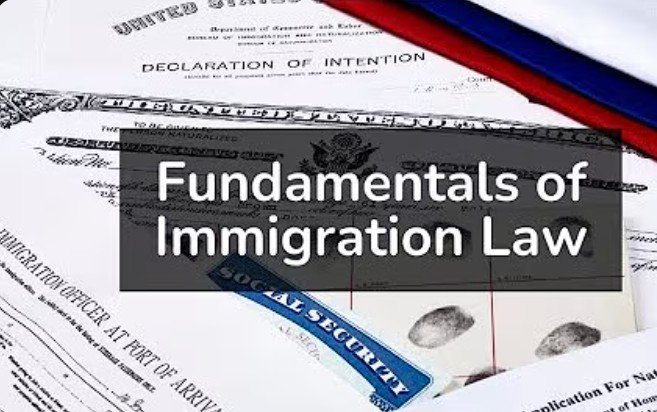Introduction
In an increasingly global world, immigration affects millions of people each year. Whether for work, education, family reunification, or asylum, immigration laws govern how people move from one country to another. These laws ensure the orderly and legal movement of individuals while protecting national security and economic interests.
This comprehensive guide to immigration law explains the legal framework, visa categories, application processes, rights of immigrants, and how an immigration lawyer can help you achieve your dream of living in a new country.
Table of Contents
- What is Immigration Law?
- Why Immigration Law Matters
- Types of Immigration
- Common Visa Categories
- Immigration Process: Step-by-Step
- Reasons for Immigration Denial
- Immigration and Asylum
- Immigration for Work and Business
- Family-Based Immigration
- Immigration for Students
- Green Cards and Permanent Residency
- Citizenship and Naturalization
- Rights and Responsibilities of Immigrants
- Role of Immigration Lawyers
- Common Challenges Faced by Immigrants
- Immigration Law Myths and Facts
- Future Trends in Immigration Law
- Conclusion
1. What is Immigration Law?
Immigration law refers to the rules, regulations, and legal procedures that govern the movement of people across borders. It defines how individuals can:
- Enter a country
- Stay for a specific duration
- Work or study legally
- Become a permanent resident or citizen
Each country has its own set of immigration laws. In the U.S., immigration law is primarily governed by the Immigration and Nationality Act (INA).
2. Why Immigration Law Matters
Immigration law impacts national security, economic development, cultural diversity, and family structures. It helps:
- Control illegal immigration
- Attract skilled workers
- Offer refuge to asylum seekers
- Reunite families
- Protect immigrant rights
3. Types of Immigration
a. Legal Immigration
Individuals enter with proper documentation and visas through a legal process.
b. Illegal Immigration
This occurs when someone enters or stays in a country without legal authorization.
c. Temporary Immigration
Includes tourists, students, and temporary workers.
d. Permanent Immigration
Individuals receive lawful permanent resident (LPR) status, also known as a green card in the U.S.
4. Common Visa Categories
a. Family-Based Visas
Allow U.S. citizens or green card holders to sponsor close relatives.
b. Employment-Based Visas
Issued to skilled professionals, seasonal workers, or investors. Common types include:
- H-1B Visa: Skilled professionals
- L-1 Visa: Intra-company transfers
- O-1 Visa: Individuals with extraordinary ability
- EB-5 Visa: Investors and entrepreneurs
c. Student Visas
- F-1 Visa: Academic students
- M-1 Visa: Vocational students
d. Refugee and Asylum Visas
Granted to individuals fleeing persecution based on race, religion, or political beliefs.
e. Diversity Visa Lottery
Also known as the Green Card Lottery, it provides a limited number of visas to countries with low immigration rates to the U.S.
5. Immigration Process: Step-by-Step
Here’s a general roadmap for immigrating legally:
Step 1: Determine Eligibility
Each visa has unique requirements. Consult the government immigration website or an immigration attorney.
Step 2: File a Petition
Usually filed by an employer or family member using forms like Form I-130 or Form I-140.
Step 3: Submit Visa Application
Once the petition is approved, file the visa application (DS-260 or I-485) depending on your status.
Step 4: Attend Biometrics Appointment
Fingerprints and photos are taken for background checks.
Step 5: Interview
Consular or USCIS interviews help verify your eligibility and intent.
Step 6: Receive a Decision
Approval results in a visa, green card, or work permit. Denials can be appealed in certain cases.
6. Reasons for Immigration Denial
Common grounds for denial include:
- Incomplete application
- Criminal background
- Security risks
- Health-related grounds (communicable diseases)
- Public charge concerns
- Fraud or misrepresentation
7. Immigration and Asylum
What is Asylum?
Asylum offers protection to individuals who are persecuted or fear persecution in their home country.
To apply for asylum in the U.S., you must:
- Be physically present in the country
- Apply within one year of arrival
- Prove fear based on race, religion, nationality, political opinion, or social group
Refugee vs. Asylee
- Refugee status is granted before entering the country
- Asylee applies after entering or at a port of entry
8. Immigration for Work and Business
Countries use immigration to attract talent and boost the economy.
a. Temporary Work Visas
Allow foreign nationals to work legally for a fixed period.
b. Permanent Work Visas (Green Card)
For highly skilled workers, researchers, and multinational managers.
c. Investor Visas (EB-5)
Applicants must invest a certain amount of capital and create U.S. jobs.
9. Family-Based Immigration
Family unity is a cornerstone of immigration law.
Who Can Sponsor?
- U.S. citizens can sponsor spouses, children, parents, and siblings.
- Green card holders can sponsor spouses and unmarried children.
Preference Categories
Some relatives fall under “preference” categories, which are subject to annual quotas.
10. Immigration for Students
Foreign students bring diversity and funding to educational institutions.
F-1 Student Visa Requirements:
- Must enroll in a full-time program
- Must have proof of financial support
- Must maintain a valid passport
Optional Practical Training (OPT)
Allows F-1 students to work in their field for up to 12 months after graduation.
11. Green Cards and Permanent Residency
What is a Green Card?
A green card is proof of lawful permanent residency, allowing one to live and work in the U.S. indefinitely.
How to Apply:
- Through family sponsorship
- Employment
- Refugee/asylee adjustment
- Special programs (DV Lottery, U Visa, etc.)
Green card holders must renew their card every 10 years and obey U.S. laws.
12. Citizenship and Naturalization
Becoming a Citizen
Naturalization is the process through which a permanent resident becomes a citizen.
Eligibility:
- 5 years of permanent residency (3 years if married to a citizen)
- Pass a civics and English test
- Demonstrate good moral character
- Take the Oath of Allegiance
Benefits:
- Right to vote
- Travel with a U.S. passport
- Protection from deportation
13. Rights and Responsibilities of Immigrants
Rights:
- Due process under the law
- Freedom of speech and religion
- Access to public education and emergency medical care
Responsibilities:
- Obey laws
- Pay taxes
- Report address changes to USCIS
- Register for selective service (for male immigrants)
14. Role of Immigration Lawyers
An immigration lawyer can:
- Help choose the correct visa
- File accurate applications
- Represent clients in court or interviews
- Help with appeals and waivers
- Avoid mistakes that lead to denials or deportation
They play a critical role in navigating the complicated and often-changing immigration landscape.
15. Common Challenges Faced by Immigrants
- Language barriers
- Culture shock
- Separation from family
- Discrimination or bias
- Uncertainty due to changing laws
- Risk of deportation
Support systems, community centers, and legal aid organizations can ease this transition.
16. Immigration Law Myths and Facts
Myth 1: “It’s easy to get a visa.”
Fact: The process is complex, with high denial rates and long wait times.
Myth 2: “Illegal immigrants don’t pay taxes.”
Fact: Many undocumented immigrants pay taxes using ITINs.
Myth 3: “Marrying a citizen guarantees a green card.”
Fact: The marriage must be bona fide and undergo strict scrutiny.
Myth 4: “Immigrants take jobs from locals.”
Fact: Immigration often fills labor gaps and drives innovation.
17. Future Trends in Immigration Law
- Digital Immigration: Online applications, biometric verification, and AI-supported interviews.
- Climate Migration: Legal frameworks for climate refugees are evolving.
- Global Talent Competition: Countries are easing laws to attract skilled workers.
- Tighter Border Policies: Many countries are tightening borders due to geopolitical tensions.
Immigration laws will continue to evolve based on global politics, economics, and humanitarian needs.
18. Conclusion
Immigration law plays a pivotal role in shaping the demographic, cultural, and economic landscape of nations. It offers opportunities, protection, and hope—but navigating it alone can be overwhelming.
Whether you’re a student, professional, refugee, or family member, understanding immigration law helps you make informed decisions. And if you face legal challenges or complex situations, hiring an immigration lawyer can make the difference between approval and denial.
The journey to a new life begins with knowledge and the right legal support. Be prepared, stay informed, and don’t hesitate to seek help when needed.






